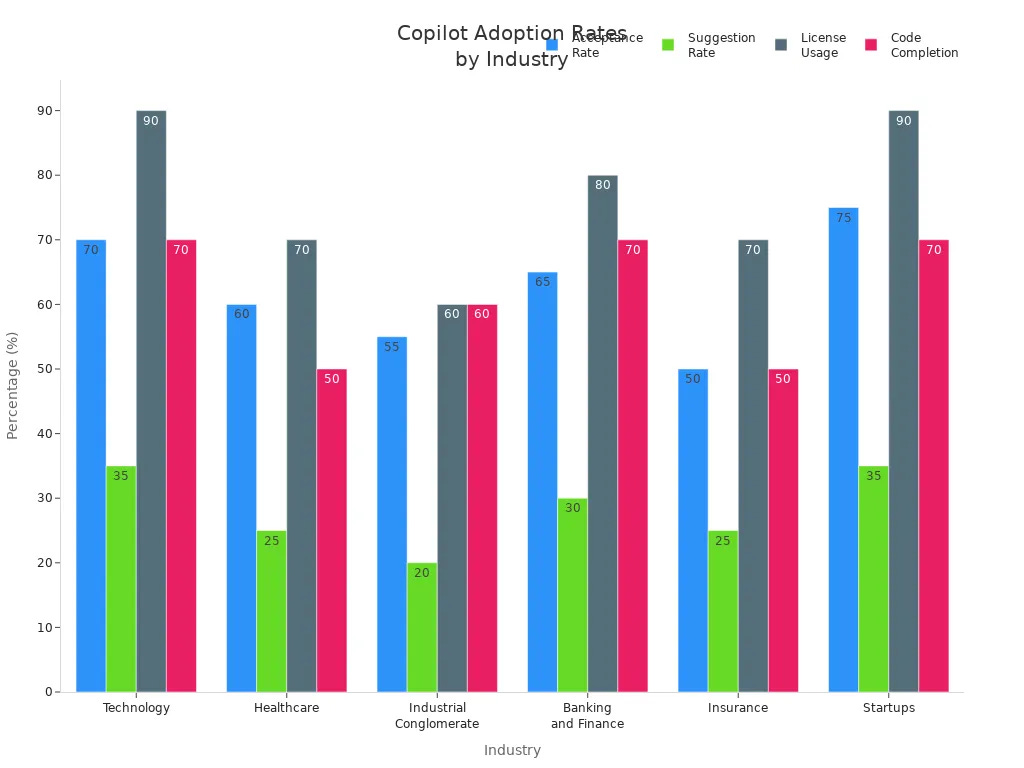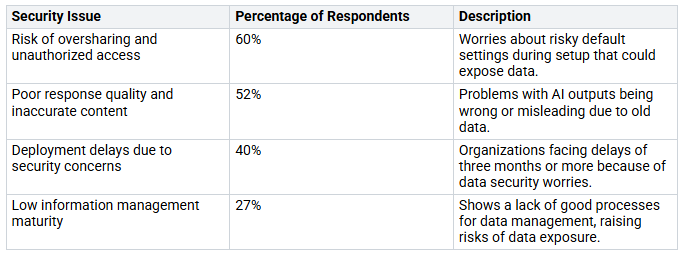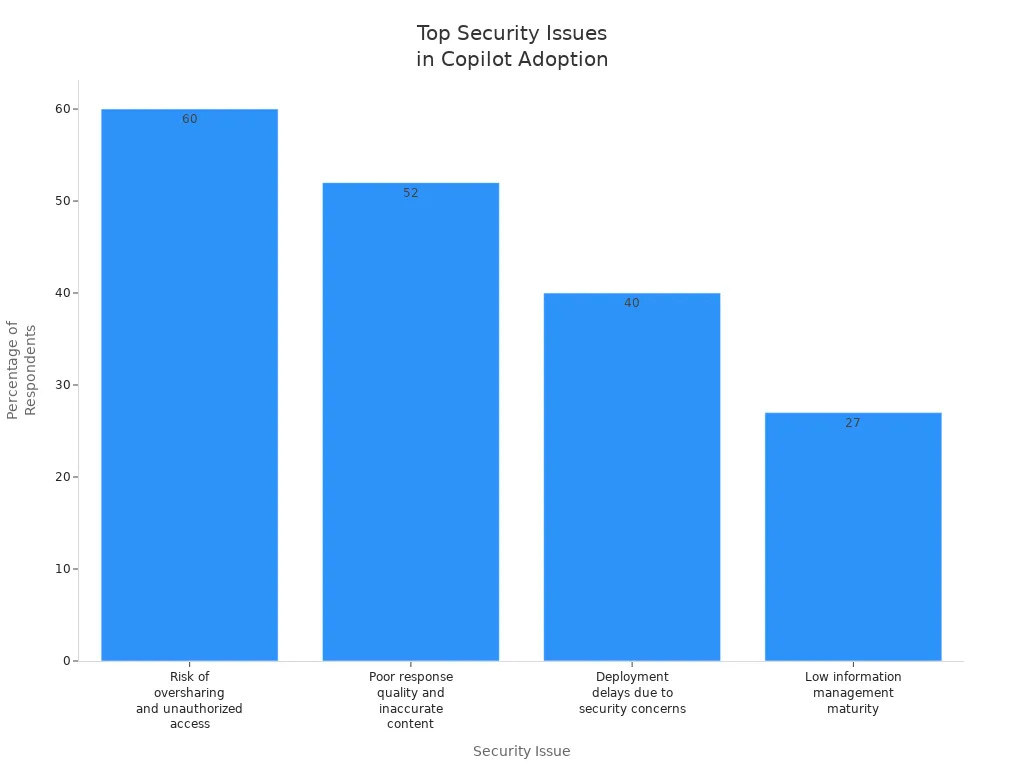In today’s busy business world, you face many challenges when using copilot technology. Knowing these problems is important for getting the most from your investment. Recent numbers show different acceptance rates in industries. Technology has a rate of 70% and startups have 75%. But, many organizations find it hard to see the promised productivity boosts. You need to clear up misunderstandings and get ready well to avoid common mistakes that can slow down Copilot use.
Key Takeaways
Know the common problems with using Copilot. These include security issues, training gaps, and people not wanting to change. Fixing these can help things go more smoothly.
Focus on data quality by organizing and managing data well. Good data is important for Copilot to give correct results and to get the most benefits.
Use a step-by-step plan to introduce Copilot. This way, you can find problems early and help users feel confident before using it fully.
Give specific training and ongoing help to workers. This makes sure they know how to use Copilot well and helps them avoid going back to old ways.
Check ROI by looking at productivity numbers and process results. Regular checks show Copilot’s value and help with future improvements.
Challenges in Copilot Adoption
Using Copilot technology has many challenges. Organizations need to handle these issues to make it work well. Knowing these challenges is important for good use and getting the most from your money. Misunderstandings and not being ready can slow you down. This can cause problems with starting and meeting goals.
Security Issues
Security worries are a big challenge during Copilot adoption. A recent survey showed that 60% of people said they worry about oversharing and unauthorized access. Wrong permissions, especially on platforms like SharePoint Online, can put private data at risk. Also, 52% of users are concerned about the quality of AI-generated content. Sometimes, this content can be wrong or misleading because of old data.
Here’s a breakdown of the most common security issues during Copilot adoption:
Also, organizations have to deal with compliance and legal risks when using Copilot. You must make sure that AI-generated content follows the rules. Not doing this can cause serious problems.
Training Gaps
Training gaps are another big problem in your Copilot adoption journey. Many organizations like social learning instead of formal training. This can lead to not using Copilot’s features enough. Users often feel unsure about how to use Microsoft Copilot, even if they see its benefits.
To fix these gaps, think about these points:
Ongoing support is important for successful use.
Employees need specific training and real-life examples to use Copilot effectively.
Without proper training, employees might go back to old ways of working, which can waste Copilot’s benefits.
Compliance Concerns
Compliance concerns are very important for organizations in regulated industries. You must deal with different compliance challenges, such as:
t handling these compliance and legal risks can lead to big fines and harm your organization’s reputation.
Resistance to Change
Resistance to change is a common issue during Copilot adoption. Employees might worry that AI will take their jobs or change their roles. This fear can cause strong pushback against new technologies.
To reduce resistance, think about these strategies:
Create a clear communication plan for different groups.
Encourage open talks about what AI can and cannot do.
Offer role-based training to show Copilot’s value in real jobs.
By addressing these worries early, you can build trust and help make the switch to using Copilot easier.
Knowing these challenges is key for successful Copilot adoption. By preparing well and clearing up misunderstandings, you can help make the implementation more effective.
Common Challenges with Microsoft Copilot Adoption
Using Microsoft Copilot has some common challenges. These problems can make it hard for your organization to succeed. Fixing these issues early can help you get the most from Copilot.
Data Quality Problems
Data quality problems often happen when adopting Copilot. If the data is not organized well or is missing, it can cause inaccurate outputs from the AI. This can lead to confusion and lower trust in the technology. Here are some key data quality challenges you might face:
Making sure the data is high-quality is very important for using Copilot well. Without good data, you risk losing the benefits of the technology.
Technical Difficulties
Technical difficulties can also slow down your Copilot adoption. Common issues include:
Connectivity Issues: Problems with the internet can cause slow responses or disconnections.
License Errors: Wrong subscription plans or missing licenses can stop access to features.
Slow Performance: Lagging can happen due to limited system resources or old setups.
You should also watch out for software bugs and glitches that can cause wrong data outputs or freezing of the Copilot interface. Fixing these technical problems quickly can help keep a smooth user experience.
Measuring ROI
Measuring ROI from Copilot adoption can be tricky. You need to look at different metrics to see how well it works. Here are some good ways to measure ROI:
Task Timing Comparisons: Write down the time taken for common tasks before and after using Copilot.
Productivity Metrics: Count the number of tasks finished each day/week compared to before Copilot.
Project Timeline Analysis: Compare how long projects take and milestones reached before and after using Copilot.
Organizations often find it hard to measure the ROI of Copilot adoption because of security worries, information management problems, and change management issues. Focusing on employee experience is very important when looking at the benefits of Copilot.
By knowing these common challenges with Microsoft Copilot adoption, you can take steps to reduce their effects and get the most from your investment.
Best Implementation Practices
Using Copilot well needs careful planning and action. By following good practices, you can help users adopt it and get the most from your investment. Here are some important strategies to think about:
Setting Clear Use Cases
It is very important to define clear use cases for Copilot. When you find specific situations where Copilot can help, you connect its abilities with your goals. Here are some tips to set good use cases:
Assess Your Current Situation: Look at your current systems to see where Copilot fits.
Define Clear Objectives: Set specific goals for what you want to achieve with Copilot.
Develop a Comprehensive Plan: Write down the steps needed to add Copilot to your organization, including training and security.
Engage Stakeholders: Involve important people in the planning to make sure the use cases meet their needs.
Monitor and Adjust: Keep checking Copilot’s performance and change your plan if needed.
By customizing use cases to fit departmental tasks, you increase the chances of successful adoption. Starting with simple tasks, like managing time and finding documents, helps users build confidence before moving on to harder tasks. This step-by-step method makes the transition easier and encourages expanding use cases later.
Phased Rollout Strategies
Using a phased rollout for Copilot can really help with adoption. This method lets you find problems and fix them before full use. Here are some benefits of this approach:
Breaking the implementation into smaller phases builds excitement while reducing disruptions. Early access to features lets your organization start seeing benefits without waiting for everything to be ready. This method also makes data integration easier at first, allowing for quicker go-live times.
Employee Engagement Techniques
Getting employees involved is key for Copilot adoption. Here are some ways to boost user engagement:
Pre-Deployment Testing & Prompt Validation: Check how Copilot fits into real work to improve user experience.
Role-Based Copilot Onboarding: Customize onboarding for different roles, showing how Copilot helps with their tasks.
Embedded Support Within Microsoft 365: Offer support right when users need it to help them learn Copilot.
Real-Time Communication & Change Enablement: Keep users updated on new features to boost adoption.
Continuous Optimization Through Analytics: Use data to see how users engage and improve adoption plans.
By addressing employee worries and giving ongoing support, you can build trust and encourage using Copilot. This proactive way makes sure Copilot becomes a regular part of daily tasks, increasing productivity and efficiency.
Aligning IT with business goals is very important for using Copilot effectively. When you make sure Copilot is not just a tool but a key asset, you improve efficiency and save costs, leading to a more productive organization.
Maximizing ROI from Copilot
Measuring Process Outcomes
To get the most return on investment (ROI) from Copilot, you need to measure how well processes work. Focus on a few key ways to see Copilot’s effects:
Leading Indicators: Use data from developers and GitHub to guess future results. This method needs little investment but gives useful insights.
Developer Surveys: Ask developers about Copilot’s effects through surveys. These surveys help you see its value and find ways to improve.
User Engagement Data: Use APIs to track numbers like Average Daily Active Users and Total Acceptance Rate. Knowing how people use it helps you make smart choices.
Monitoring Frequency: Check system-level measures regularly with your engineering schedule. Aim for weekly or bi-weekly checks to keep assessing how well Copilot works.
Building Success Stories
Making success stories is important to show Copilot’s value in your organization. Start by finding specific examples where Copilot has helped a lot. Share these stories with stakeholders to create excitement and support for wider use. Point out measurable results, like higher productivity or shorter task times.
Think about using a pilot program strategy. Choose key pilot groups, create clear use cases, and set up feedback loops. This method helps you improve your use of Copilot and show real benefits, proving its importance in reaching your business goals.
Long-term Data Management
Managing data over the long term is very important for keeping ROI from Copilot. Here are some key practices to think about:
Keep data secure and follow rules to maintain trust in AI outputs.
Use automated tools for data management to lower risks with AI. This is even more important as permissions get more complex.
Regularly check and update security policies. With 50% of permissions seen as high risk, being proactive is key to protecting sensitive data.
By focusing on these areas, you can boost Copilot’s effectiveness and ensure long-term success. Continuous improvement practices, like enhancing your data setup and providing targeted training, will strengthen your investment in Copilot.
To successfully use Copilot, you need a smart plan. Focus on solving problems and getting the most from your investment. Here are some important lessons from organizations that did well:
Use summaries for missed meetings to stay updated.
Create follow-up meeting plans based on past talks.
Also, ongoing training and sharing knowledge are very important for getting leaders involved. As you think about the future, expect trends like a 30% productivity increase from Copilot and the need for organized onboarding. By using these strategies, you can make Copilot a helpful tool that improves efficiency and fits your business goals.
FAQ
What is Copilot, and how does it work?
Copilot is a tool that uses AI to help users with different tasks. It creates content and gives suggestions. It works with your current systems to make work faster and easier.
How can I ensure data quality when using Copilot?
To keep data quality high, set clear rules for managing data, use the same names for things, and clean your data often. Good data is very important for Copilot to give correct results.
What training resources are available for Copilot users?
Organizations should offer training based on roles, ongoing help, and real-life examples. These resources help users learn about Copilot’s features and get the most out of it in their daily work.
How can I measure the ROI of Copilot adoption?
You can measure ROI by looking at how long tasks take, checking productivity numbers, and comparing project timelines before and after using Copilot. Focus on clear results to see its effects well.
What strategies can reduce resistance to using Copilot?
To lower resistance, talk openly about the benefits of Copilot, listen to employee worries, and give specific training. Building trust and showing value will help people start using it.
















